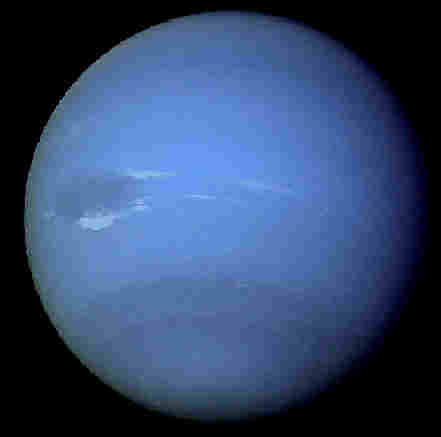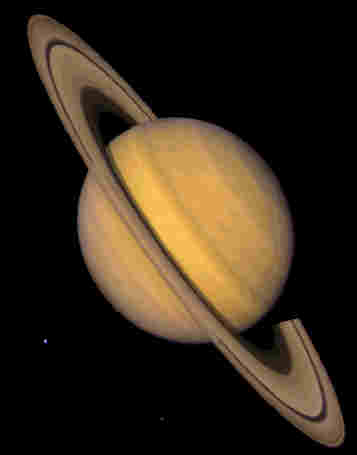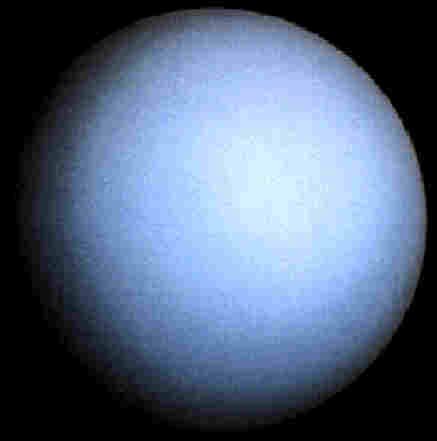|

Uranus
|
Our knowledge of the gas giant planets comes from two sources, ground
based telescopes and spacecraft. Because of their great distance from Earth
and the interference of the Earthís atmosphere, telescopes are of limited
use in gathering scientific information about these planets. The most detailed
information about the gas giants has come from 1) the Voyager 1 and 2
spacecraft, which visited these planets, starting in 1979, and from the
Galileo probe which orbited around Jupiter. Scientists are really just
beginning to learn about these planets. They have only a general
understanding of their composition, structure, magnetic properties, and
other characteristics.
The atmospheres of the four gas giant planets are composed largely of
hydrogen and helium. The upper atmospheres of both Jupiter and Saturn are
mostly hydrogen; scientists hypothesize that much of this material has sunk
into the interiors of the two planets. The upper atmospheres of Uranus and
Neptune seem to have somewhat larger fractions of helium.
The colors of the gas giant planets are due to gasses in their upper
atmospheres. The visible surface clouds of Jupiter and Saturn are mainly
ammonia ice. Trace impurities give these clouds their coloration, such as
the reddish tints of Jupiter's Great Red Spot. Methane is 10 times as
abundant in the atmospheres of Uranus and Neptune as the atmospheres of
Jupiter and Saturn. The abundance of methane makes Uranus and Neptune both
appear blue to human eyes. Methane absorbs red and orange light in their
atmospheres.
|

Saturn
|
On each of the gas giant planets, the atmospheres are organized into
zones that run parallel to the equator. These zones range from prominent on
Jupiter and to almost indistinguishable on Uranus. These zones are
controlled by a stable pattern of planetary winds. On Jupiter wind speeds
vary with latitude and shift from easterly to westerly many times between
the equator and the pole. Storm activity, in the form of swirling oval
patches, can be seen on Jupiter, Saturn, and Neptune but not on Uranus.
The temperatures of the upper atmosphere of the gas giants are quite hot.
For Jupiter the temperatures are in excess of 1000EK, 600-800°K for Saturn, and
750-800°K
for Uranus and Neptune. The minimum temperature for Jupiter is 110°K,
for Saturn is 80°K, Uranus is 52°K and Neptune is 50°K.
|

Neptune
|
All four of the gas giants have magnetic fields. Scientists explain how
the fields are generated using the dynamo theory. Essentially, each of the
gas giants has a core which is partially liquid metallic hydrogen. As this
material circulates, it generates electrical energy, which creates the
magnetic field. The magnetic fields are dipolar; they have well defined
north and south magnetic poles. Magnetic forces travel from the negative to
the positive pole. On the studentís diagram below, the magnetic field is
shown as imaginary lines of force. The magnetic poles
of the gas giant planets correspond only poorly with the their rotational
axes. The reasons for this, especially the wide divergence seen in Uranus,
are not clear.
PROCEDURE:
- Use the worksheets to compare the gas giant planets with Earth. You
may wish to review their relative sizes, distances from the Sun,
rotational speeds, and other features.
- Compare the magnetic fields of each of the planets using the diagram.
The dashed line shows the planetís rotational axis, the solid straight
lines show the equator of each planet, and the curved solid lines show
the directions of the magnetic field. In particular, note that magnetic
fields of Uranus and Neptune are vastly different from the Earth's
because they are greatly offset from the rotational axis.
- Stress to students that scientists do not know all there is about
these gas giants. Future information will help us to
understand these giants. Remember these worksheets are for students to
compare and contrast, not to memorize.